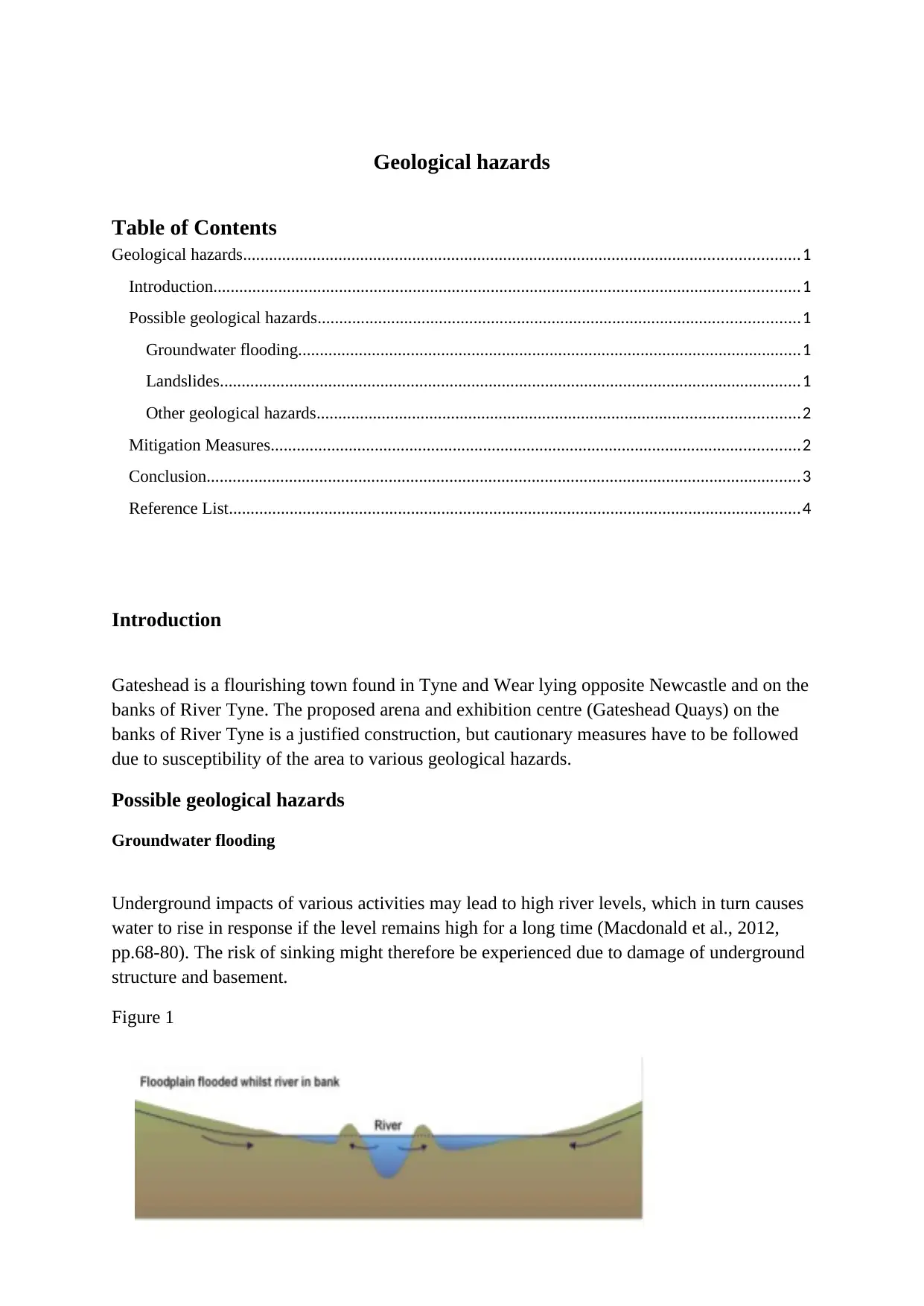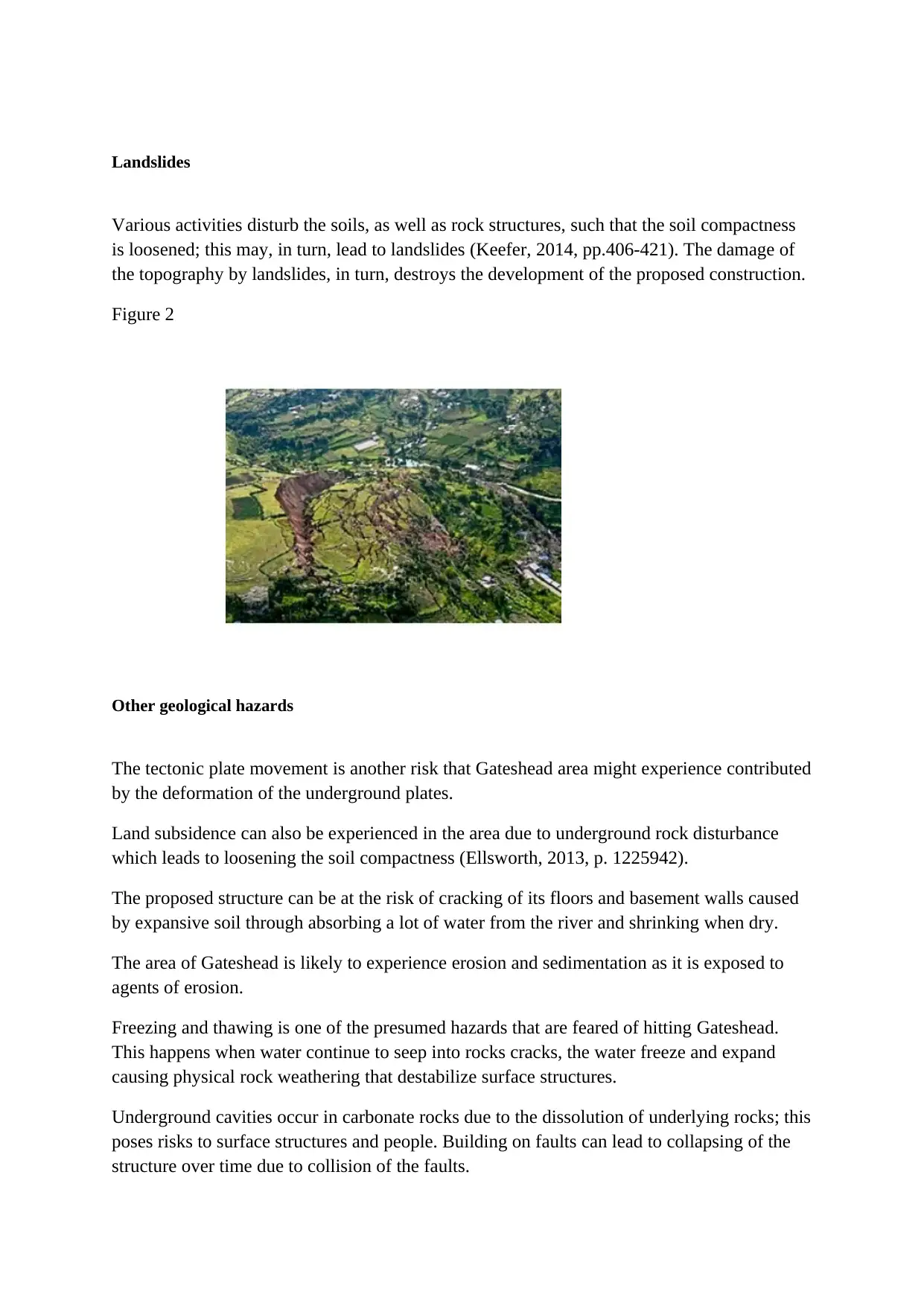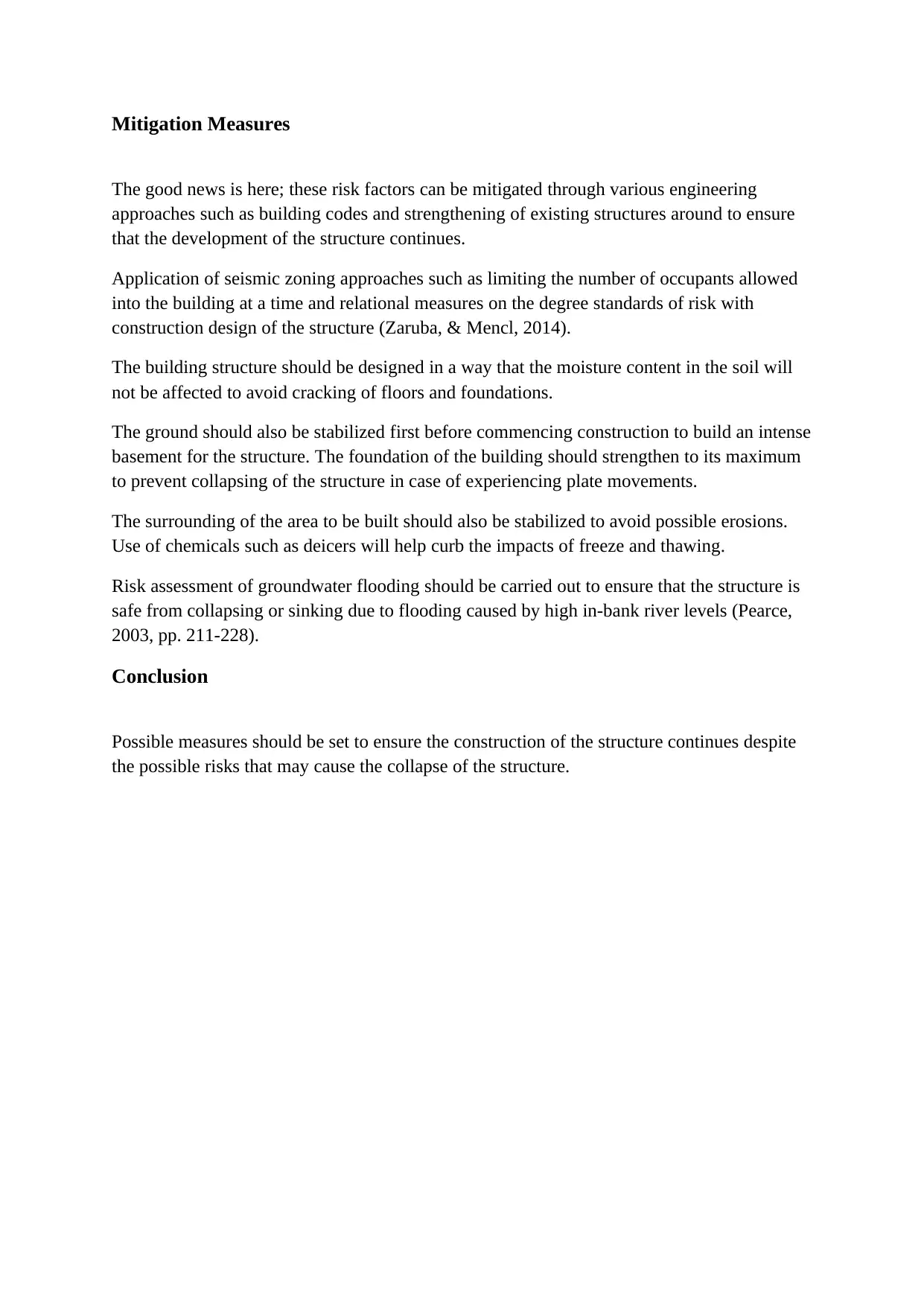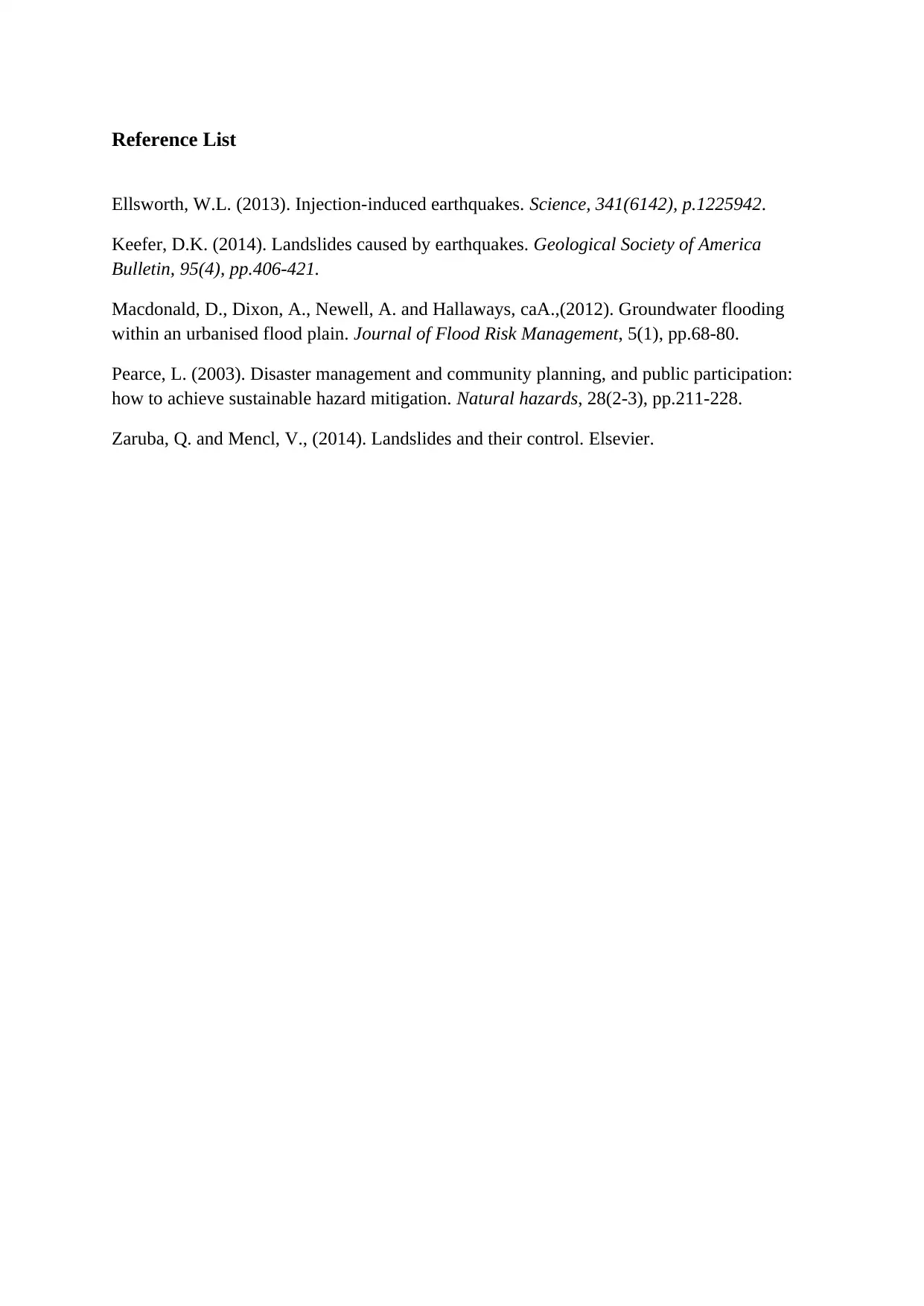Geological Hazards Report: Mitigation for Gateshead Quays Construction
VerifiedAdded on 2022/09/07
|4
|798
|16
Report
AI Summary
This report assesses potential geological hazards impacting the proposed arena and exhibition center (Gateshead Quays) in Tyne and Wear. It identifies risks including groundwater flooding, landslides, ground collapse, land subsidence, soil contamination, and the effects of freezing and thawing. The report provides detailed explanations of each hazard, referencing the site's geological characteristics and past industrial activities. Furthermore, it explores mitigation measures such as building codes, seismic zoning, ground stabilization, and foundation strengthening to ensure the project's structural integrity and safety. The report emphasizes the importance of risk assessment and proactive engineering approaches to address both natural and human-induced hazards, ensuring the successful and safe completion of the construction project.

Geological hazards
Table of Contents
Geological hazards................................................................................................................................1
Introduction.......................................................................................................................................1
Possible geological hazards...............................................................................................................1
Groundwater flooding....................................................................................................................1
Landslides......................................................................................................................................1
Other geological hazards...............................................................................................................2
Mitigation Measures..........................................................................................................................2
Conclusion.........................................................................................................................................3
Reference List....................................................................................................................................4
Introduction
Gateshead is a flourishing town found in Tyne and Wear lying opposite Newcastle and on the
banks of River Tyne. The proposed arena and exhibition centre (Gateshead Quays) on the
banks of River Tyne is a justified construction, but cautionary measures have to be followed
due to susceptibility of the area to various geological hazards.
Possible geological hazards
Groundwater flooding
Underground impacts of various activities may lead to high river levels, which in turn causes
water to rise in response if the level remains high for a long time (Macdonald et al., 2012,
pp.68-80). The risk of sinking might therefore be experienced due to damage of underground
structure and basement.
Figure 1
Table of Contents
Geological hazards................................................................................................................................1
Introduction.......................................................................................................................................1
Possible geological hazards...............................................................................................................1
Groundwater flooding....................................................................................................................1
Landslides......................................................................................................................................1
Other geological hazards...............................................................................................................2
Mitigation Measures..........................................................................................................................2
Conclusion.........................................................................................................................................3
Reference List....................................................................................................................................4
Introduction
Gateshead is a flourishing town found in Tyne and Wear lying opposite Newcastle and on the
banks of River Tyne. The proposed arena and exhibition centre (Gateshead Quays) on the
banks of River Tyne is a justified construction, but cautionary measures have to be followed
due to susceptibility of the area to various geological hazards.
Possible geological hazards
Groundwater flooding
Underground impacts of various activities may lead to high river levels, which in turn causes
water to rise in response if the level remains high for a long time (Macdonald et al., 2012,
pp.68-80). The risk of sinking might therefore be experienced due to damage of underground
structure and basement.
Figure 1
Paraphrase This Document
Need a fresh take? Get an instant paraphrase of this document with our AI Paraphraser

Landslides
Various activities disturb the soils, as well as rock structures, such that the soil compactness
is loosened; this may, in turn, lead to landslides (Keefer, 2014, pp.406-421). The damage of
the topography by landslides, in turn, destroys the development of the proposed construction.
Figure 2
Other geological hazards
The tectonic plate movement is another risk that Gateshead area might experience contributed
by the deformation of the underground plates.
Land subsidence can also be experienced in the area due to underground rock disturbance
which leads to loosening the soil compactness (Ellsworth, 2013, p. 1225942).
The proposed structure can be at the risk of cracking of its floors and basement walls caused
by expansive soil through absorbing a lot of water from the river and shrinking when dry.
The area of Gateshead is likely to experience erosion and sedimentation as it is exposed to
agents of erosion.
Freezing and thawing is one of the presumed hazards that are feared of hitting Gateshead.
This happens when water continue to seep into rocks cracks, the water freeze and expand
causing physical rock weathering that destabilize surface structures.
Underground cavities occur in carbonate rocks due to the dissolution of underlying rocks; this
poses risks to surface structures and people. Building on faults can lead to collapsing of the
structure over time due to collision of the faults.
Various activities disturb the soils, as well as rock structures, such that the soil compactness
is loosened; this may, in turn, lead to landslides (Keefer, 2014, pp.406-421). The damage of
the topography by landslides, in turn, destroys the development of the proposed construction.
Figure 2
Other geological hazards
The tectonic plate movement is another risk that Gateshead area might experience contributed
by the deformation of the underground plates.
Land subsidence can also be experienced in the area due to underground rock disturbance
which leads to loosening the soil compactness (Ellsworth, 2013, p. 1225942).
The proposed structure can be at the risk of cracking of its floors and basement walls caused
by expansive soil through absorbing a lot of water from the river and shrinking when dry.
The area of Gateshead is likely to experience erosion and sedimentation as it is exposed to
agents of erosion.
Freezing and thawing is one of the presumed hazards that are feared of hitting Gateshead.
This happens when water continue to seep into rocks cracks, the water freeze and expand
causing physical rock weathering that destabilize surface structures.
Underground cavities occur in carbonate rocks due to the dissolution of underlying rocks; this
poses risks to surface structures and people. Building on faults can lead to collapsing of the
structure over time due to collision of the faults.

Mitigation Measures
The good news is here; these risk factors can be mitigated through various engineering
approaches such as building codes and strengthening of existing structures around to ensure
that the development of the structure continues.
Application of seismic zoning approaches such as limiting the number of occupants allowed
into the building at a time and relational measures on the degree standards of risk with
construction design of the structure (Zaruba, & Mencl, 2014).
The building structure should be designed in a way that the moisture content in the soil will
not be affected to avoid cracking of floors and foundations.
The ground should also be stabilized first before commencing construction to build an intense
basement for the structure. The foundation of the building should strengthen to its maximum
to prevent collapsing of the structure in case of experiencing plate movements.
The surrounding of the area to be built should also be stabilized to avoid possible erosions.
Use of chemicals such as deicers will help curb the impacts of freeze and thawing.
Risk assessment of groundwater flooding should be carried out to ensure that the structure is
safe from collapsing or sinking due to flooding caused by high in-bank river levels (Pearce,
2003, pp. 211-228).
Conclusion
Possible measures should be set to ensure the construction of the structure continues despite
the possible risks that may cause the collapse of the structure.
The good news is here; these risk factors can be mitigated through various engineering
approaches such as building codes and strengthening of existing structures around to ensure
that the development of the structure continues.
Application of seismic zoning approaches such as limiting the number of occupants allowed
into the building at a time and relational measures on the degree standards of risk with
construction design of the structure (Zaruba, & Mencl, 2014).
The building structure should be designed in a way that the moisture content in the soil will
not be affected to avoid cracking of floors and foundations.
The ground should also be stabilized first before commencing construction to build an intense
basement for the structure. The foundation of the building should strengthen to its maximum
to prevent collapsing of the structure in case of experiencing plate movements.
The surrounding of the area to be built should also be stabilized to avoid possible erosions.
Use of chemicals such as deicers will help curb the impacts of freeze and thawing.
Risk assessment of groundwater flooding should be carried out to ensure that the structure is
safe from collapsing or sinking due to flooding caused by high in-bank river levels (Pearce,
2003, pp. 211-228).
Conclusion
Possible measures should be set to ensure the construction of the structure continues despite
the possible risks that may cause the collapse of the structure.
⊘ This is a preview!⊘
Do you want full access?
Subscribe today to unlock all pages.

Trusted by 1+ million students worldwide

Reference List
Ellsworth, W.L. (2013). Injection-induced earthquakes. Science, 341(6142), p.1225942.
Keefer, D.K. (2014). Landslides caused by earthquakes. Geological Society of America
Bulletin, 95(4), pp.406-421.
Macdonald, D., Dixon, A., Newell, A. and Hallaways, caA.,(2012). Groundwater flooding
within an urbanised flood plain. Journal of Flood Risk Management, 5(1), pp.68-80.
Pearce, L. (2003). Disaster management and community planning, and public participation:
how to achieve sustainable hazard mitigation. Natural hazards, 28(2-3), pp.211-228.
Zaruba, Q. and Mencl, V., (2014). Landslides and their control. Elsevier.
Ellsworth, W.L. (2013). Injection-induced earthquakes. Science, 341(6142), p.1225942.
Keefer, D.K. (2014). Landslides caused by earthquakes. Geological Society of America
Bulletin, 95(4), pp.406-421.
Macdonald, D., Dixon, A., Newell, A. and Hallaways, caA.,(2012). Groundwater flooding
within an urbanised flood plain. Journal of Flood Risk Management, 5(1), pp.68-80.
Pearce, L. (2003). Disaster management and community planning, and public participation:
how to achieve sustainable hazard mitigation. Natural hazards, 28(2-3), pp.211-228.
Zaruba, Q. and Mencl, V., (2014). Landslides and their control. Elsevier.
1 out of 4
Your All-in-One AI-Powered Toolkit for Academic Success.
+13062052269
info@desklib.com
Available 24*7 on WhatsApp / Email
![[object Object]](/_next/static/media/star-bottom.7253800d.svg)
Unlock your academic potential
Copyright © 2020–2025 A2Z Services. All Rights Reserved. Developed and managed by ZUCOL.


